9 of the Toughest Mountains in America You Can Shockingly Actually Summit

Have you ever stared up at a towering mountain and thought, “I want to conquer that?” Well, you’re not alone! As someone who’s on a mission to climb the highest peak on each continent, I’ve made it a personal goal to at least see, if not summit, some of the hardest mountains to climb in the US.
Summitting these mountains are not for the faint-hearted, but it’s definitely an adventure worth pursuing for those who crave the achievement and thrill of the ascent. America is home to some of the most challenging yet accessible peaks that can seriously test your limits while delivering jaw-dropping rewards at the summit.
Get ready to push your boundaries; this list is packed with some of America’s most formidable mountains you can actually conquer. Get ready to lace up your boots—these peaks are calling!
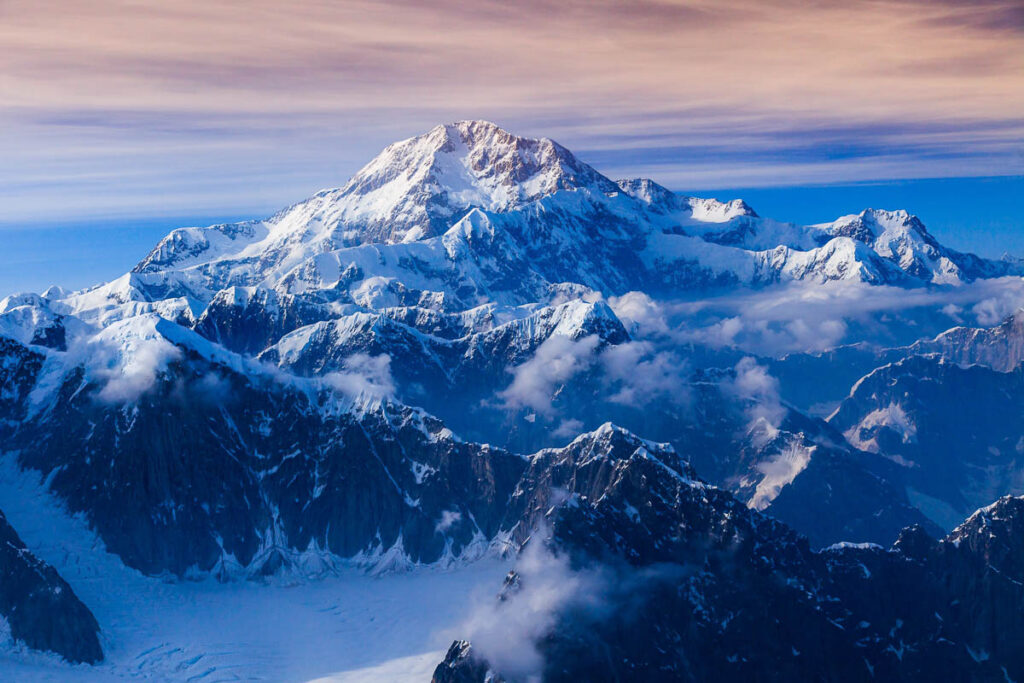
1. Denali, Alaska
- Elevation: 20,310 feet
- Duration: 2-4 weeks
- Difficulty: Extreme; Notorious for harsh weather and high altitude
Denali, formerly known as Mount McKinley, holds the title of the highest peak in North America and the third most prominent peak in the world. Located in Alaska’s Denali National Park and Preserve, Denali is a colossal challenge that stands tall at 20,310 feet. The mountain’s name translates to “The Great One” in the native Koyukon language.
How to Climb: There are multiple routes for climbers, but all require extensive mountaineering experience and preparation due to extreme weather conditions and technical challenges. Only about half of those who attempt to summit this mountain succeed each year.
The West Buttress route is the most popular path to the summit, where climbers will need to establish multiple camps at various altitudes to acclimatize properly. The journey involves weeks of hauling heavy sleds, crossing deep crevasses, and battling fierce winds and snowstorms.
🏔 For an alternative way to see the summit of Mt Denali, take a flight around this bucket list destination
📖 Read Also: The Top 8 Hardest Hikes in US National Parks and Why They’re Worth It
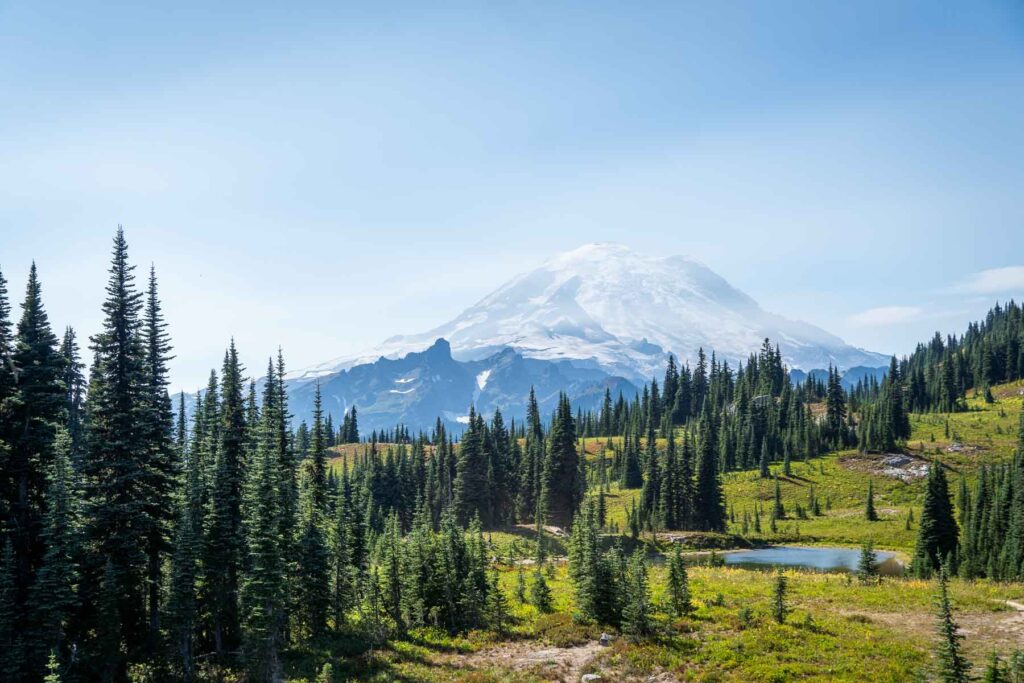
2. Mount Rainier, Washington
- Elevation: 14,411 feet
- Duration: 2-3 days
- Difficulty: Extreme; known for glaciers and unpredictable weather.
Mount Rainier isn’t just any mountain; it’s an active stratovolcano that dominates the Seattle skyline. Standing at 14,411 feet, it’s the tallest peak in the Cascade Range and one of the most glaciated mountains in the contiguous United States. With over 25 major glaciers, the mountain can even create its own weather patterns thanks to its massive size!
How to Climb: Climbing Mount Rainier is certainly doable with the right preparation and mindset. The most popular route to the summit is the Disappointment Cleaver (or “DC”) route. Prepare for an early start; many teams set off around midnight to take advantage of firmer snow conditions and avoid the risk of rockfall as the day warms up.
You’ll start your journey at the Paradise trailhead until you hit the Muir Snowfield. From here, it’s a steep climb up the Ingraham Glacier and Disappointment Cleaver before making the final push to the summit. Along the way, you’ll navigate crevasses, seracs, and steep ice slopes, so you’ll need to be comfortable with glacier travel and self-arrest techniques. Reaching the summit gives you a breathtaking panoramic view that stretches from Mount St. Helens to Mount Hood on a clear day.
📖 Read Also: 10 of the US National Parks’ Most Iconic Landmarks

3. Grand Teton, Wyoming
- Elevation: 13,775 feet
- Duration: 1-2 days
- Difficulty: Challenging; Famous for its technical climbs and views
As the prominent peak within Grand Teton National Park in Wyoming, this iconic peak has inspired countless adventurers with its sharp, rugged profile. Believe it or not, Grand Teton was once thought to be “unclimbable” until the first documented ascent in 1898.
From the summit on a clear day, you can look out over the entire Teton Range, with its jagged peaks stretching out like a row of saw teeth. The Snake River snakes its way through the Jackson Hole valley below, and to the west, you might catch a glimpse of Idaho.
How to Climb: Climbing Grand Teton is insanely steep, and its exposed granite faces require technical climbing skills. The classic route is called “Owen-Spalding” and involves a mix of hiking, scrambling, rappelling, and technical rock climbing. Climbers must navigate narrow ledges, sheer drops, and vertical cliffs while dealing with high-altitude exposure.
📖 Read Also: Perfect One Day in Grand Teton Itinerary for First-Timers

4. Mount Whitney via Mountaineer’s Route, California
- Elevation: 14,505 feet
- Duration: 1-3 days
- Difficulty: Challenging; Known for its high altitude and steep terrain
Climbing Mount Whitney, the highest peak in the contiguous US and one of California’s most sought-after climbing destinations is a real achievement for anyone who makes it to the top. The mountain’s standard route via its eastern approach provides an easier trek to the summit, but take on the Mountaineer’s Route for a real challenge.
How to Climb: The Mountaineer’s Route is a class 3 (and sometimes class 4) scramble through steep and exposed terrain, requiring significant scrambling and route-finding skills.
From Whitney Portal, you’ll head up and encounter steep inclines, slabs of granite, and the treacherous Ebersbacher Ledges. Near the summit, you’ll encounter the “Notch.” Standing at the peak, you’ll be rewarded with unbeatable 360-degree views of the Golden State. Permits are required for this hike here.
📖 Read Also: 11 American Places So Surreal, You’ll Think They’re Photoshopped

5. Mount Hood, Oregon
- Elevation: 11,239 feet
- Duration: 6-8 hours
- Difficulty: Difficult
Mount Hood, affectionately known as Wy’east by the Multnomah tribe, is not just Oregon’s tallest peak but also one of the most prominent landmarks in the entire Pacific Northwest. It’s a stratovolcano that’s also considered potentially active. With its striking silhouette visible from miles away, Mount Hood has been luring climbers for generations.
How to Climb: The South Side route is considered the “beginner’s route” up Mount Hood, but it’s by no means easy. This climb is usually attempted in the early morning hours (or even pre-dawn) for firmer snow and safer conditions. On the way to the summit, you will encounter steep snow and ice slopes, crevasses, and rockfall hazards. It requires basic mountaineering skills, such as using crampons and an ice axe, as well as proper safety gear.
More experienced climbers may choose more technical routes, such as the Leuthold Couloir or the most challenging Yocum Ridge, which involves steep and exposed ridges with significant fall potential.
📖 Read Also: 25 Beautiful Places in Oregon That Will Give You Instant Travel Envy

6. Mount Shasta, California
- Elevation: 14,179 feet
- Duration: 1-2 days
- Difficulty: Strenuous
Mount Shasta is a massive Northern California volcano near the Oregon border. It’s also one of the most iconic peaks in the state, with its classic volcano shape and snow-capped summit. Despite being relatively close to major cities like San Francisco and Sacramento, Mount Shasta remains an untamed wilderness and a huge draw to hippies for its spiritual energy.
How to Climb: The most popular route up Mount Shasta is via Avalanche Gulch, a long uphill slog through boulder fields, ice chutes, and steep snow slopes. Climbers will need to navigate around bergschrunds (large cracks in glaciers) and potential rockfall hazards on the way. Mount Shasta is known for its unpredictable and sometimes treacherous weather patterns.
More experienced climbers can tackle routes like Casaval Ridge or Hotlum-Bolam Ridge, which are more technically challenging with ice and rock climbing sections.
📖 Read Also: Think Yellowstone Has All the Hot Springs? These 6 National Parks Beg to Differ
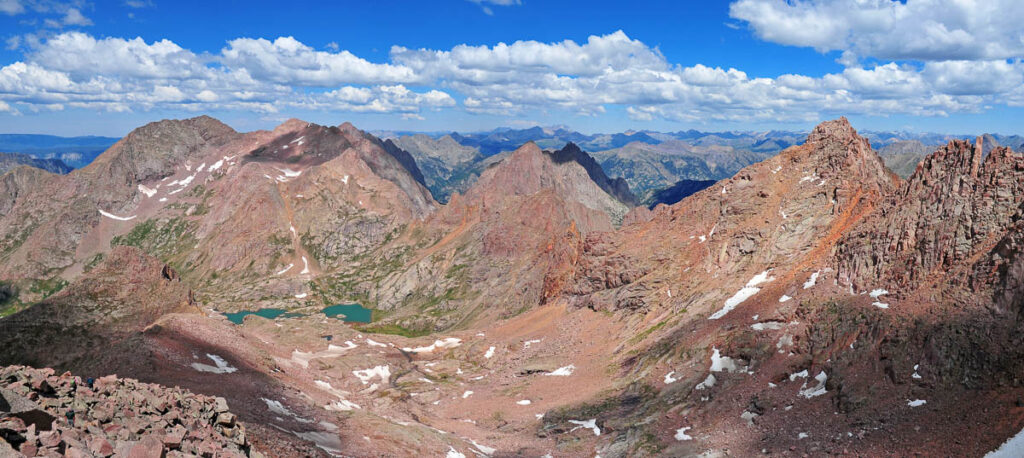
7. Capitol Peak, Colorado
- Elevation: 14,130 feet
- Duration: 1-2 days
- Difficulty: Very difficult; Notorious for its exposed knife-edge ridge and dangerous rockfall hazards
Capitol Peak is a prime example of the wild but harsh beauty of the Colorado Rocky Mountains. Located in the Elk Mountains of Colorado, it is often considered one of the state’s most challenging “fourteeners” (mountains with elevations above 14,000 feet). Its striking summit pyramid features a precarious and exposed knife-edge ridge that requires advanced climbing skills.
How to Climb: The standard route up Capitol Peak is via the northeast ridge, also known as “Knife Edge.” And yes, it lives up to its name with a narrow ridgeline that drops off on both sides. This climb requires mountaineering skills, technical rock climbing abilities, and nerves of steel. On the way to the summit, you’ll also face exposure to potential rockfall, steep snow chutes, and loose rocks.
Otherwise, there are many other options, like the “Climbers’ Route,” which involves technical climbing and traversing treacherous sections like the “K2.”
📖 Read Also: The Best Way to Spend One Day in Rocky Mountain for First-Timers
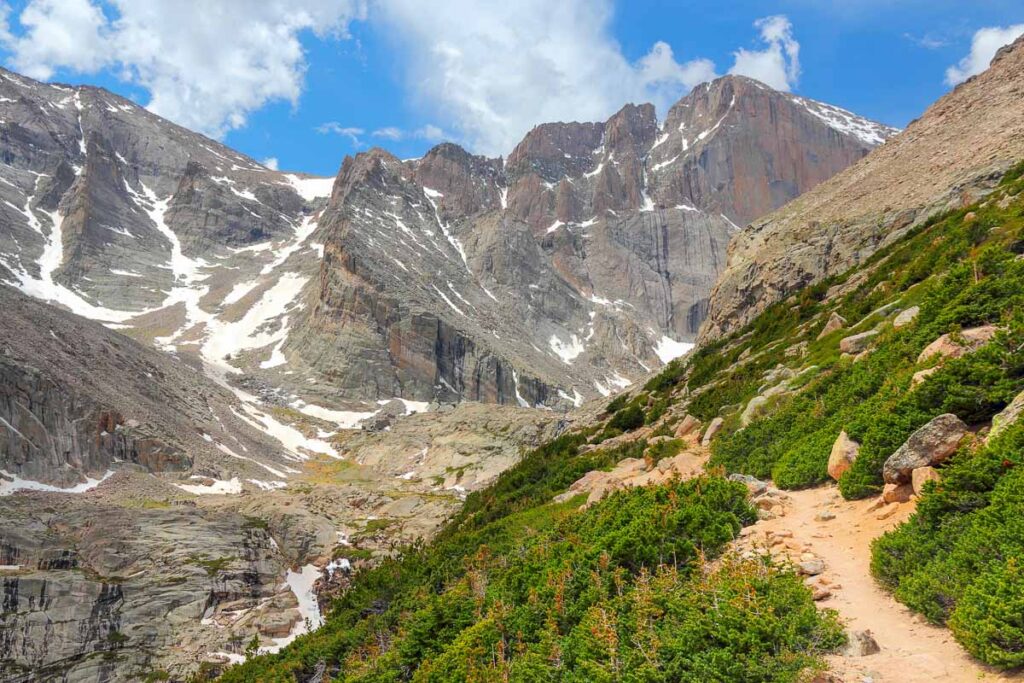
8. Longs Peak via The Diamond, Colorado
- Elevation: 14,259 feet
- Duration: 1-2 days
- Difficulty: Very difficult; Technical rock climbing on “The Diamond.”
Longs Peak is the highest summit in Rocky Mountain National Park and one of Colorado’s most iconic peaks. Its towering east face, known as “The Diamond,” draws experienced climbers from around the world to attempt some of the most technical and exposed routes in the state.
How to Climb: The classic route up Longs Peak via The Diamond involves a multi-pitch rock climb with exposed vertical walls, cracks, and chimneys. It’s rated at 5.10d (expert level) and requires advanced rock climbing skills such as trad climbing, face climbing, and route-finding. This climb should not be attempted without proper training and experience, as it is considered one of the most dangerous routes in Colorado.
Other challenging routes up Longs Peak include the Keyhole Route, which involves scrambling and exposed ridges, and the North Face Cables Route, which requires technical ice-climbing skills.
📖 Read Also: 8 American National Parks That Keep Showing Up in Your Favorite Films
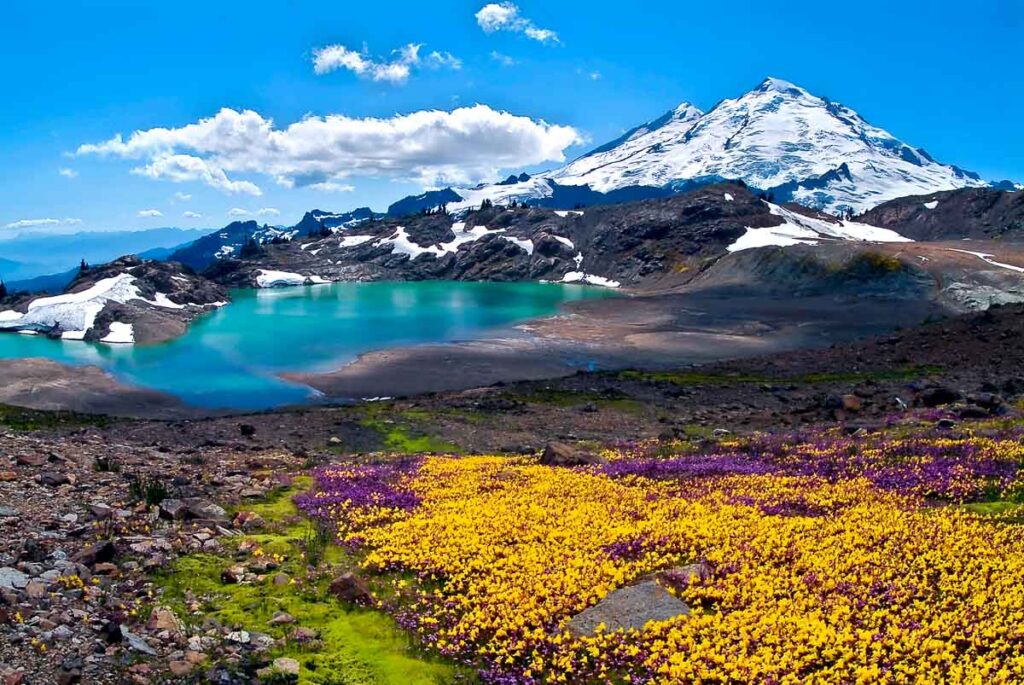
9. Mount Baker, Washington
- Elevation: 10,781 feet
- Duration: 1-2 days
- Difficulty: Strenuous; Technical glacier travel and crevasse navigation.
Mount Baker is an active stratovolcano located in the Northern Cascades of Washington. As one of the snowiest places on Earth, Mount Baker has dazzling glaciers and ice formations. The Lummi tribe calls it Koma Kulshan (or “Great White Watcher”).
How to Climb: The most popular route up Mount Baker is via the Easton Glacier or the Coleman-Deming Route, which have relatively gentler slopes for more glacier travel beginners. On any route, you must navigate crevasses and steep snow slopes.
For a more technical ascent, climbers can attempt the North Ridge or Coleman Headwall Route, which involves exposed ridges, steep ice sections, and potential rockfall hazards.
📖 Read Also: 14 Western US State Parks That Rival Any National Park
Final Thoughts: Hardest Mountains to Climb in the US
While countless other challenging mountains in the US could easily make this list, these nine stand out as some of the most difficult and sought-after summits. Each of them requires a significant amount of preparation, physical fitness, and technical skills.
Keep exploring new routes, pushing your limits, and respecting the beauty and power of these incredible peaks. And who knows, maybe one day you’ll join the ranks of elite climbers who have conquered these ultimate challenges.
And if you liked this post, check out our guide to some of the hardest hikes in the US National Park System.
Before you Close That Tab…Looking for More Inspiration?
- The Top 8 Hardest Hikes in US National Parks and Why They’re Worth It
- 11 Dreamy Lakes in West USA That Will Take Your Breath Away
- 9 Overrated Tourist Traps in the US to Steer Clear of During Your Next Road Trip
Catherine, a seasoned travel writer, has lived in 4 different states and explored 36 states and 28 national parks. After spending two years embracing van life, she's now dedicated to sharing her vast knowledge of day trips across America. Catherine's other works has been referenced in major publications like MSN, Self, and TripSavvy.
| MY FAVORITE TRAVEL RESOURCES |
✈️ Find amazing guided tours and experiences with Viator to maximize your time! 🏘️ Plan ahead and secure your accommodation with Booking.com in advance. 🧾 Rent a car with Discovercars in advance and get the best prices for your day trip adventures. |

